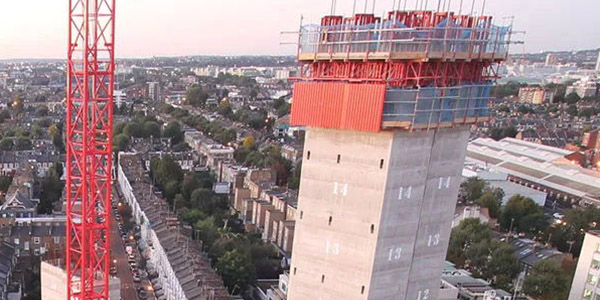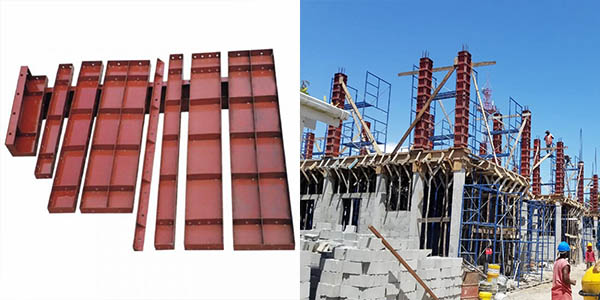Understanding Different Types Of Steel Formwork
Aug 19, 2024In this article, we will look at the various types of steel formwork on the market, such as slip formwork and fixed formwork, each of which serves its purpose and has its own advantages. We will then focus on why steel formwork is superior to other materials, the steps in the steel formwork process, and advice to maximize its use and life expectancy.
Commonly, steel formwork (metal shuttering) can be classified into two types, slip formwork and easy formwork, which are two forms that have distinctive functionality in varying construction conditions.
Slip formwork is an unusual type of formwork that is constantly relocated upward or downward as concrete. Rather than constructing multiple levels of formwork in taller structures, it allows for the creation of continuous, elevated structures, such as high-rise buildings, silos, and chimneys. Slip-formwork structures are almost always internally braced and supported by hydraulic jacks or guide columns for smooth, consistent movement in a continuous upward or downward motion for construction.
The slip-formwork construction method is very favorable where continuous concrete walls are desired because there are no construction joints to worry about, thus lessening concerns of structural weak points. Slip steel formwork designs are also considered time-effective because they speed up construction time, which can be particularly advantageous with taller structures requiring multiple set ups of traditional formwork information.

There exist six categories of slip formworks, which differ based on the construction direction:
■ Vertical slip formworks - the slip formwork is intended for slip formworking vertical infrastructure; the workers work on a working platform to place the reinforcement on a working platform and keep a smooth concrete pour. The concrete slip formwork and working platform rises vertically through a system of hydraulic jacks.
■ Horizontal slip formworks - the slip steel formwork is for slip formworking pavements, traffic barriers, etc.; a hydraulic jack allows the concrete to be laid, vibrated, processed, and locked in place; while a hydraulic jack slowly advances the slip formwork during the concrete placement process.
■ Conical slip formworks - the slip formwork is used to slip formwork tall structures such as conical chimneys, cooling towers, and piers; the slip formwork slips gradually through either using a working platform or method; the overlapping acceptance of the slip formwork allows for varitions in dimensions of the wall and diameter; in using for architectural concrete, the joints are obviously apparent so not recommended.
■ Cantilever slip formworks - slip formwork independent of the crane, which is for self-lifting large area formwork systems; it can be used for walls, columns, floor supports, and transitioning when the area changes in dimension.
■ Egg slip formworks - generally used based on the principles of jump molds; able to change axis and vertical circumferential slope to adapt to any geometry.
■ Conical slip formworks - the slipconstructed from cantilever plates and overlapping plates; self-leveling aspect of the can easily accommodate wide and varying taper and wall thickness at the same time; fixed on a steel bracket.
Notable Uses:
Fixed formwork is another widely used steel formwork system, used to form and support concrete until it has cured and gained enough strength to support itself. Unlike slip formwork, fixed formwork is placed at a specific location and remains there during the curing process. Fixed formwork is a more versatile formwork system and is used for various other types of concrete structures.
Fixed formwork is divided into two general systems:

Large-size formwork is authorized for pouring large concrete surfaces, including walls and slabs with large surface areas. Large size formwork systems are mostly prefabricated and in a single pour, can cover a large surface area, which decreases construction time and work and aesthetics.
Large-size formwork systems are prevalent in large structure applications such as office buildings, commercial buildings, or industrial buildings where consistency and time reduction is critical.
Key Application areas include:

Small-size formwork is adaptable and allows for the production of smaller, more detailed formwork elements such as columns, beams, and stairs. Owing to its multi-faceted nature, small-size formwork is suited to work with complex geometries and irregular shapes when giving a precise shape to reinforced concrete.
Small-size formwork is highly capable in detail work is compact space where larger formwork would be heavy and impractical. For this reason, small-size formwork is very popular for residential and commercial construction.
Specific Applications:
The first use of concrete formwork is steel formwork to create concrete, providing some benefit.
The procedure for applying steel formwork occurs through the following:
• Design and Planning: Design and planning is vital to make sure the formwork system suits the definition of the project, allows for tolerances, and the work is aligned.
• Installation: The formwork system is installed and aligned to prevent any movement while the concrete is being placed as well as bolted/ restrained.
• Pour and Cure Concrete: Concrete is placed and poured into the system and formed, and then must cure in order to allow the concrete to set - and strengthen.
• Removal of Formwork: After curing, the formed structure is reapplied to the work site. Finally, the formwork system should be cleaned and inspected in order to function for the future.
The steel formwork care and maintenance includes the following processes, to ensure extended life and performance of the system:
Steel formwork, selected for construction today, has strength, accuracy and flexibility built-in. This blog post indicated various types of steel formwork you would see today, especially siding and fixed formwork and their various features such as durability, reuse and flexibility.
If you want to work with steel formwork, the process should be planned out well in advance, from design, to installation, pouring the concrete, to removal. With proper maintenance and care (and repairs when needed) the material has the ability provide durable, long lasting service.
The merits of being aware of and thinking about these principles will give the construction professional a more efficient approach, and as a result a higher quality product. Steel formwork contributed strength to a concrete structure as well as contributed to more sustainable modern construction principles.
Is Steel Formwork Better Than Wood Formwork?
How Many Times Can Steel Formwork Be Reused?
What Are The Types Of Reusable Formwork?
Steel Formwork|PPT --- SLIDESHARE
Formwork --- WIKIPEDIA
Top 5 Formwork Types --- VINCIVILWORLD